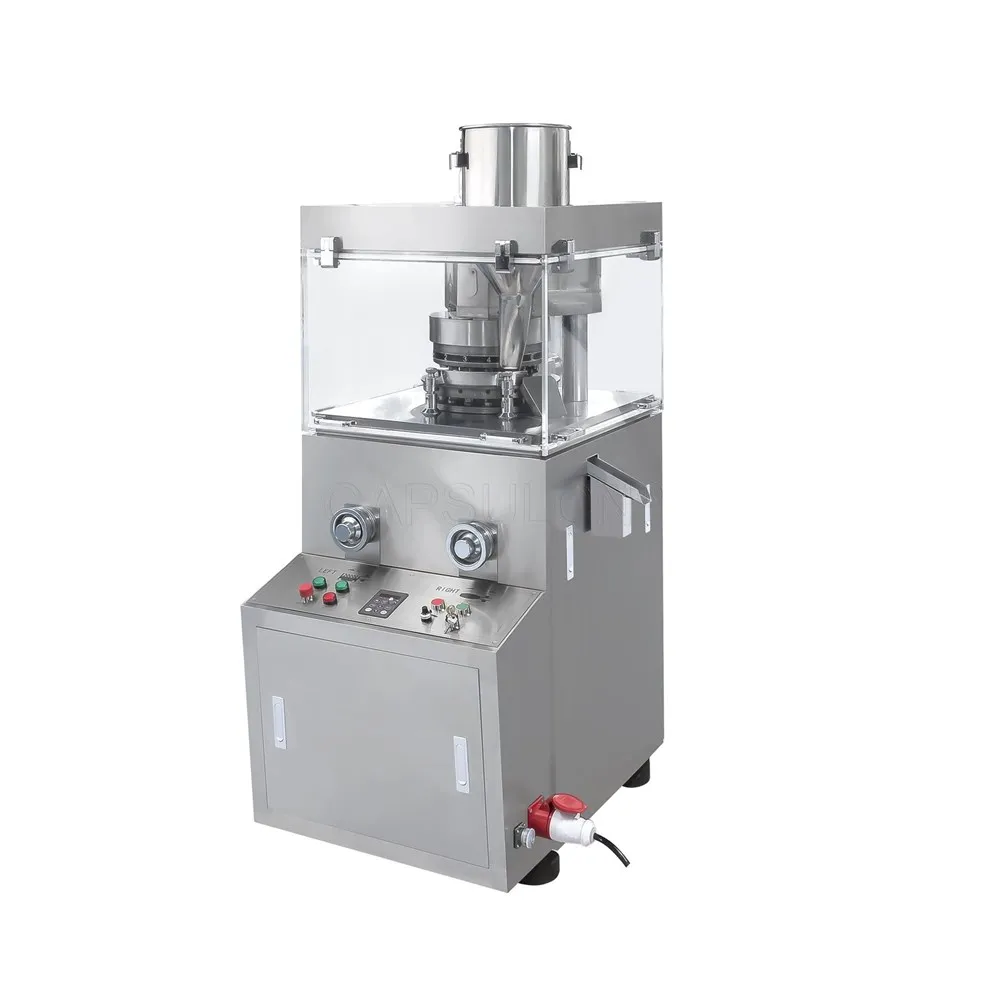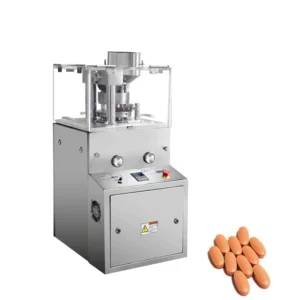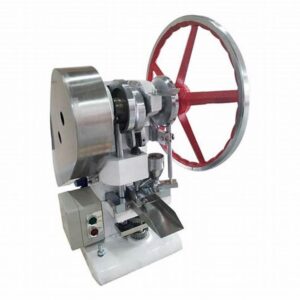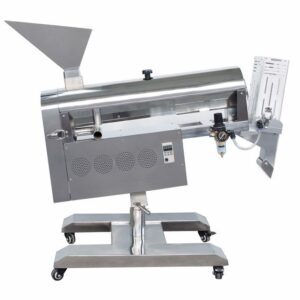Description
| Feature | Specification |
|---|---|
| Model | ZPW Rotary Tablet Press |
| Maximum Pressure | 80 kN |
| Maximum Tablet Diameter | 25 mm |
| Maximum Filling Depth | 20 mm |
| Production Capacity | Up to 60,000 tablets/hour |
| Number of Stations | 15, 23, 31, or custom |
| Main Motor Power | 5.5 kW |
| Overall Dimensions (LxWxH) | Varies based on configuration |
| Weight | Varies based on configuration |
| Material of Construction | Stainless Steel or as per request |
| Control System | PLC control system |
| Safety Features | Overload protection, Emergency stop button, Interlocking system |
The ZPW Rotary Tablet Press is a complex device that compresses powder mixtures into tablets of equal size and weight. It works on the principle of compression whereby powdered material is put in die cavities and forced under high pressure to form tablets. This process has several stages that are important for ensuring the quality and integrity of the final product.
Working Processes of the ZPW Rotary Tablet Press
Powder Feeding: The first step involves feeding powered material into the tablet press machine. Typically this material consists of active pharmaceutical ingredients (APIs), excipients, and other necessary additives used in the formulation of tablets.
Die Filling: Once fed to the machine, the powder is directed through feed frames or hoppers into the die cavities. These are molds with precisely shaped die cavities that determine the size and shape of tablets.
Compression: During this stage, upper and lower punches pressurize powder within die cavities thereby compacting it into solid tablets. The application of compression force is regulated to ensure a uniform hardness/thickness throughout all compressed tablets.
Ejection: Finished compressed tablets are removed from the die cavities by the lower punches and conveyed to collection points for further processing or packaging.
Tablet Inspection: Throughout tablet production, quality control measures are implemented to inspect them for defects thereby ensuring compliance with regulatory standards.
Applications of the ZPW Rotary Tablet Press
ZPW rotary tablet press has numerous applications in the pharmaceutical industry where it is used for producing different kinds of tables including:
Immediate Release Tablets: Those kinds that release their active ingredients quickly upon ingestion giving fast therapeutic action are called immediate release tablets e.g pain killers such as analgesics like paracetamol/antacids/antipyretics
Sustained Release Tablets: These formulations also known as extended-release formulations allow the gradual release of the drug over an extended period leading to prolonged therapeutic effect at reduced frequency of dosing. They may be used in drugs requiring steady blood levels like some cardiovascular drugs or anti-depressants.
Enteric-Coated Tablets: In enteric coatings, the tablet is protected against degradation in the gastric acid so that the active ingredients are released into the intestines rather than the stomach. This is very useful for drugs that may cause irritation or require specific pH conditions for absorption.
Chewable Tablets: Such tablets are chewed before swallowing thus making them suitable for patients who have difficulties with swallowing conventional tablets and capsules hence they are widely used in pediatric and geriatric formulations.
Effervescent Tablets: These tables contain components that react with water resulting in the release of carbon dioxide causing effervescence or fizzing. They are common in over-the-counter remedies such as antacids and painkillers.
Functions of the ZPW Rotary Tablet Press
The ZPW rotary tablet press has several functions that it performs in pharmaceutical manufacturing:
High-Speed Production: The rotary design of the ZPW tablet press combined with multiple compression stations enables high production speeds which considerably increase output and efficiency.
Precision and Consistency: The size, weight, and hardness uniformity of all tablets produced by this machine are necessary since it is vital to maintain dose accuracy and efficacy.
Flexibility: This machine can accommodate different sizes, shapes as well and formulations for a variety of drug products hence allowing the production of diverse products needed in the market by pharmaceutical manufacturers.
Quality Assurance: It has features for real-time monitoring and control that enable continuous quality assessment thereby maintaining compliance with regulatory standards.
Ease of Operation: The present-day models of ZPW Tablet Press are featured with user-friendly interfaces and automation capabilities that make operating the system easier and minimize risks for errors.
Future Trends in ZPW Rotary Tablet Press Technology
Many factors in the pharmaceutical industry will shape future tablet press technology trends:
Industry 4.0 Technologies Integration: Application of smart manufacturing principles like IoT (internet of things), data analytics, and artificial intelligence among others will enable real-time monitoring and optimization of tablet press operations to improve efficiency and quality.
Advanced Material Handling Systems: The use of modern material handling systems will help to improve powder feeding accuracy as well as minimize wastage thus optimizing the process of manufacturing tablets.
Increased Automation and Robotics: There will be an increased level of automation in tablet press operations leading to higher throughput, lower labor costs, and enhanced safety.
Continuous Manufacturing: Continuous wet granulation, direct compression et al are the emerging techniques that can offer advantages such as scalability, process efficiency, product quality, etc.
Enhanced Quality Control Measures: Progresses made on sensor technology and inline monitoring systems are now able to immediately detect defects or deviations hence leading a real-time production with the least number of rejects.
Roles and Advantages of ZPW Rotary Tablet Press
Primary Manufacturing Equipment: This is because it is a key instrument used in making drugs therefore lowering cost while improving quantity output ratio at one time It means highly efficient production machinery on which most pharma companies rely heavily to produce high volumes at low costs per unit volume.
Cost Savings: In addition, there is a further reduction in manual labor input requirements through streamlining of the tableting processes resulting in down pricing by manufacturers so that they do not lose market power against other competitors.
Quality Assurance: It ensures consistency in terms of compression force control, and tablet weight control among other parameters based on which regulatory standards are set by various governments across the globe relating consumer safety aspects as well as efficacy demands from any finished medicine dosage form making this machine to be one of the most critical devices in QMS for any pharma company.
Product Innovation: It allows product differentiation and hence pharmaceutical companies can easily develop new dosage forms and improve patient compliance by using various formulation and shape options provided by this tablet press on different medications.
Global Impact: This is why patients across the world must have access to high-quality, affordably priced drugs made with the aid of ZPW Rotary Tablet Press technology as a way of addressing healthcare needs globally such as public health emergencies.
FAQs
1. What is a ZPW Rotary Tablet Press?
A sophisticated drug-making machine designed to compress powdered materials into solid tablets is called a ZPW Rotary Tablet Press. It follows the principle of compression which involves placing powder into die cavities where it’s compacted under tremendous pressure forming tablets with uniform weight, size, and shape.
2. How does a ZPW Rotary Tablet Press work?
The working mechanism of the ZPW Rotary Tablet Press encompasses several steps. At first, the powdered material is sent into the machine via die cavities. Afterward, upper and lower punches compress the powder resulting in tablet-shaped ones. Finally, finished tablets are removed from the dies’ holes after they have been ejected and harvested for further processing or packaging activities.
3. What are the main applications of a ZPW Rotary Tablet Press?
Immediate release, sustained release, enteric-coated, chewable, and effervescent among others are some types of tablets produced by pharmaceutical industries using this machine since it allows for a wide range of formulations and shapes thereby making it adaptable for different medication requirements.
4. What functions does a ZPW Rotary Tablet Press serve in pharmaceutical manufacturing?
The primary functions of a ZPW Rotary Tablet Press are high-speed production, perfect and consistent tablet formation, flexibility to create varied tablet formulations, quality assurance by real-time monitoring and control, and ease of operation with user-friendly interfaces and automation capabilities.
5. What are the future trends in ZPW Rotary Tablet Press technology?
Future trends for ZPW Rotary Tablet Press technology comprise industry 4.0 technologies like IoT, and AI; advanced material handling systems; increased automation and robotics; adoption of continuous manufacturing techniques; and use of sensor technology and inline monitoring systems for better quality control.
6. How does a ZPW Rotary Tablet Press contribute to cost savings in pharmaceutical manufacturing?
It helps in reducing production costs by streamlining the process of tablet making, reducing manual labor as well as optimizing production efficiency which helps them remain competitive among others. Additionally, its automation capabilities minimize errors incurring further savings on costs.
7. What role does a ZPW Rotary Tablet Press play in ensuring tablet quality?
This is achieved by adhering to certain measures that include compression force control during the entire manufacturing process to maintain consistency when it comes to tablets’ weight among other parameters. These help manufacturers meet regulatory requirements while still preserving product efficacy/safety.
8. How does a ZPW Rotary Tablet Press facilitate product innovation in the pharmaceutical industry?
For instance, one can set up different types of shapes/forms hence allowing such innovations while improving patient convenience and adherence at once. This will drive medication delivery improvement hence bettering care given to patients.
9. What is the global impact of ZPW Rotary Tablet Press technology on healthcare?
ZPW rotary table press medical machines produce cheap but quality drugs that improve health worldwide because they cover public health diseases by enabling accessibility to basic drugs needed by patients suffering from various diseases.
10. How does the ZPW Rotary Tablet Press shape the future of medicine and patient care?
The evolution has seen an increase in demand for medications with improving access and costs of medications, continued high product quality and safety standards, and pharmaceutical manufacturing innovation which the ZPW rotary tablet press is in the forefront. Its development will enhance global healthcare delivery.





Reviews
There are no reviews yet.